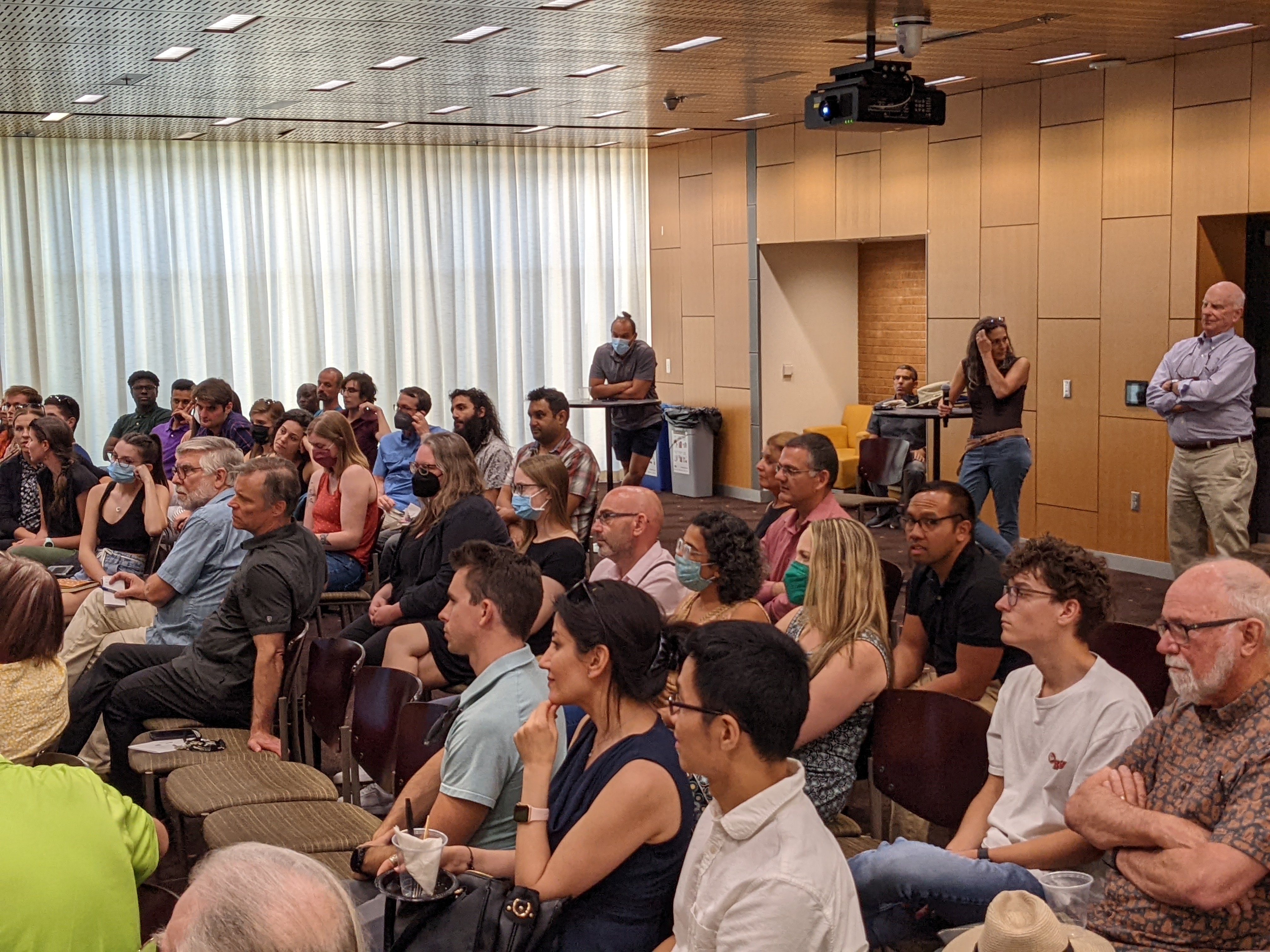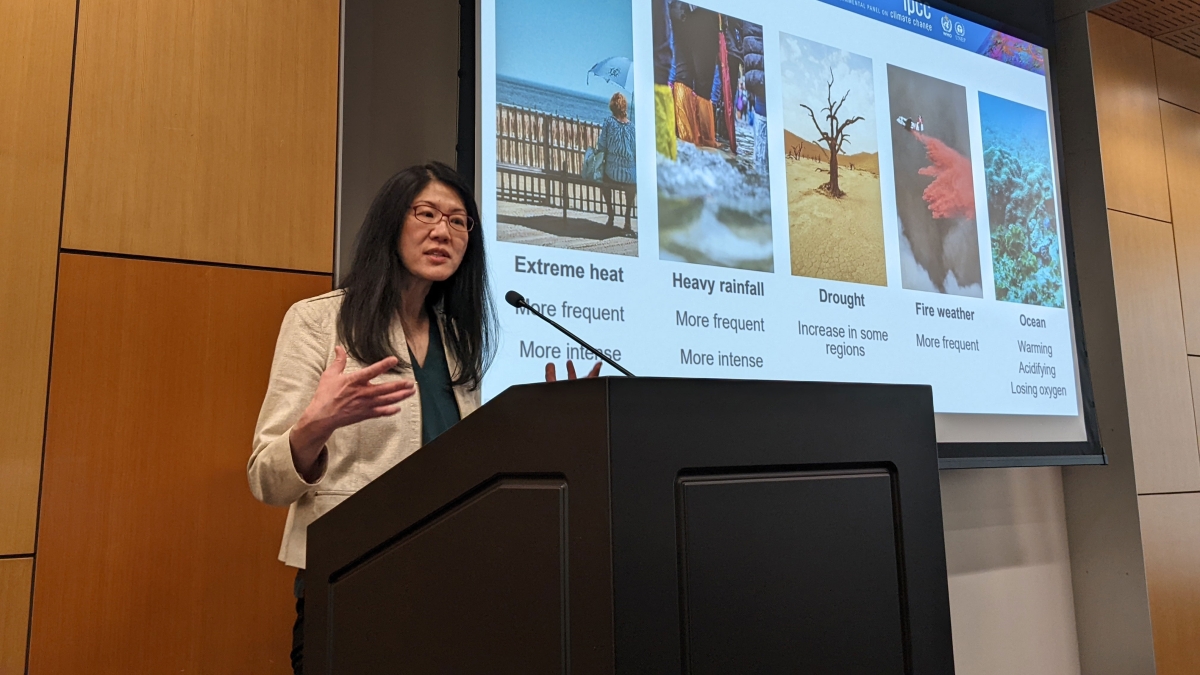The science is out and unequivocally clear: Climate change is a threat to human well-being and the health of the planet. In the last decade, urban infrastructure and activities caused about two-thirds of today's greenhouse gas emissions — and while cities continue to be a big driver of emissions, one urban climate expert says that they too need to be critical pieces of our climate solutions.
Karen Seto, co-lead author of the urban mitigation chapter of the United Nations Intergovernmental Panel Climate Change (IPCC) Sixth Assessment Report and a professor at Yale University, spoke to nearly 100 Arizona State University researchers, community members and students last week at the Anthony J. Brazel Lecture hosted by ASU's Urban Climate Research Center.
The title of her talk was “Cities and Climate Change: Key Findings From the IPCC 6th Assessment Report.”
“Speakers such as Dr. Seto bring important perspectives to our ongoing work on climate, enhancing our discourse and growing our global research network,” said David Sailor, director of ASU's Urban Climate Research Center and professor in the School of Geographical Sciences and Urban Planning. “I’m particularly proud of the opportunity that the Brazel lecture gives our students and young researchers to interact with luminaries in the field.”
According to the UN’s latest series of climate change reports, the past decade saw the highest level of average yearly greenhouse gas emissions from human activities ever recorded, and a startling companion message from the report: “We’re simply not on track to limit warming to 1.5 degrees Celsius” — the internationally recognized threshold that if breached would result in extreme natural catastrophes like severe droughts, food shortages and extreme heat waves all around the globe.
“Any further delay in concerted global action will miss the brief, rapidly closing window to secure a liveable future,” said Seto to a full crowd in ASU’s Memorial Union Alumni Room. “We have this window, and it’s rapidly closing.”
As the world’s population is expected to rise by 2 billion people within the next 30 years, with nearly 70% of the world’s population estimated to live in cities, the call for action becomes even more urgent and personal.
While a handful of cities across the world have already begun adapting to reduce their emissions, and adaptation is increasing all across the globe, progress is still uneven and not happening fast enough, Seto says, especially in the places that are most at-risk to a warming climate’s effects.
“We need to simply accelerate adaptation,” Seto said. “No cities are safe from climate change impacts until all cities are safe from climate change impacts.”
Solutions across all sectors
The latest U.N. report outlines mitigation strategies and solutions across different critical sectors and discusses the practical steps that cities — which are at the confluence of all these sectors — can take to help curb greenhouse gas emissions.
Strategies across different sectors include:
Major transitions in energy to low- or no-carbon energy systems and the electrification of our energy systems (energy sector).
Transitioning to low-carbon transportation like electric vehicles or changing demand to use less vehicles in more walkable cities; and transitioning to alternative fuels (transport sector).
Retrofitting existing buildings rather than building new buildings (building sector).
Leveraging new technology that enables us to be more efficient to reuse, recycle and minimize waste (industry sector).
Prioritizing carbon capture as a key part of the solution space to get to net zero emissions (land use sector).

Karen Seto spoke to a room of nearly 100 ASU researchers, community members and students at the Anthony J. Brazel Lecture last week, hosted by ASU’s Urban Climate Research Center. Photo courtesy of David Sailor
Additionally, Seto emphasized a new sector included for the first time in the U.N.’s report on climate change, focused on practical solutions around changing “demand and services.”
“It's really clear that we can have a very high standard of living and still reduce our demand for energy,” Seto said.
The U.N.’s report shows that if we change demand, it has the potential to bring down global emissions by 40–70% by 2050.
“It’s about changing how frequently we use our cars; it's how frequently we get the new iPhone; it's (about) changing our consumption habits: walking, cycling, public transport; it’s transitioning to a more sustainable diet,” Seto said. “It really focuses on what we can do as individuals to change our consumption habits.”
But Seto made it clear that if we do not first have infrastructure that is designed for us to walk or take public transit, these are not options at the local level. Urban planning must play an important role for cities to create the opportunities for people to change behavior.
Not one-size-fits-all
Seto says that the literature is clear that urban mitigation strategies will be different for different types of cities based on a city’s unique physical characteristics and how fast it is expected to grow.
“Are you in a city that's rapidly growing, or are you in an established city, and what kind of footprint do you have?” said Seto. “That will actually determine the entry point for whether you should focus on spatial planning or whether you should focus on electrification or really focus on changing demand.”
For a city like Tempe, she imagines a focus on spatial planning, and then also identifying entry points for changing demand and behavior.
Prioritizing climate change
Moving into the future, Seto says that although technology exists to advance many of these urban solutions, two large obstacles to implementing these solutions still exist: green finance and political will.
“I don’t know of any city that thinks that climate change is the No. 1 thing that they should (deal with),” Seto said. “We need to think about the policy hooks or strategy hooks that will engage city leaders, and that will vary depending on the city.”
Seto explains it could start with reframing how we communicate climate change adaptation as a co-benefit, with other issues taking the lead role.
“Right now, we're thinking you need to do climate change and the co-benefit is health, and co-benefit is improved jobs. Well, no, that's not how cities think about it. Cities think, ‘How do I bring in more jobs?’” Seto said. “I'm absolutely convinced having read so many papers for the assessment that we have the solutions, but it's a matter of packaging them together and thinking about what is feasible.”
As part of that, Seto believes that with both the science and solutions in hand, what is missing now is a parallel process that takes the cutting-edge science and implements it.
“When we think about the implementation, the implementation is going to vary by country, by capacity, by geography, by priorities. And so, I'm not really sure how to organize it,” Seto said. “How can we not just hand over this report, but be part of the solution to implement the report?
“Part of why I'm here is to hear from all of you what you think. I think all of us have a role to play in being part of the solution.”
The Urban Climate Research Center (UCRC) at ASU is a globally recognized and respected group of scholars studying a wide range of urban climate topics. Composed of nearly 40 faculty affiliates across eight schools at ASU, UCRC employs a collaborative social/physical science framework to address critical issues in the urban atmospheric environment. Learn more at https://sustainability-innovation.asu.edu/urban-climate.
Top photo: Karen Seto delivers the the Anthony J. Brazel Lecture. Photo courtesy of David Sailor
More Environment and sustainability

A 6-month road repair that only takes 10 days, at a fraction of the cost? It's reality, thanks to ASU concrete research
While Arizona’s infrastructure may be younger than its East Coast counterparts, the effects of aging in a desert climate have begun to take a toll on its roads, bridges and railways. Repairs and…

Mapping DNA of over 1 million species could lead to new medicines, other solutions to human problems
Valuable secrets await discovery in the DNA of Earth’s millions of species, most of them only sketchily understood. Waiting to be revealed in the diversity of life’s genetic material are targets for…

From road coatings to a sweating manikin, these ASU research projects are helping Arizonans keep their cool
The heat isn’t going away. And neither are sprawling desert cities like the metro Phoenix area.With new summer records being set nearly every year — 2024 was the warmest year on record for…


